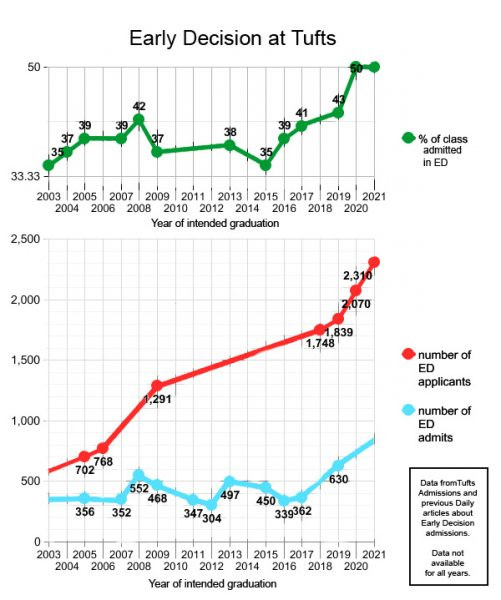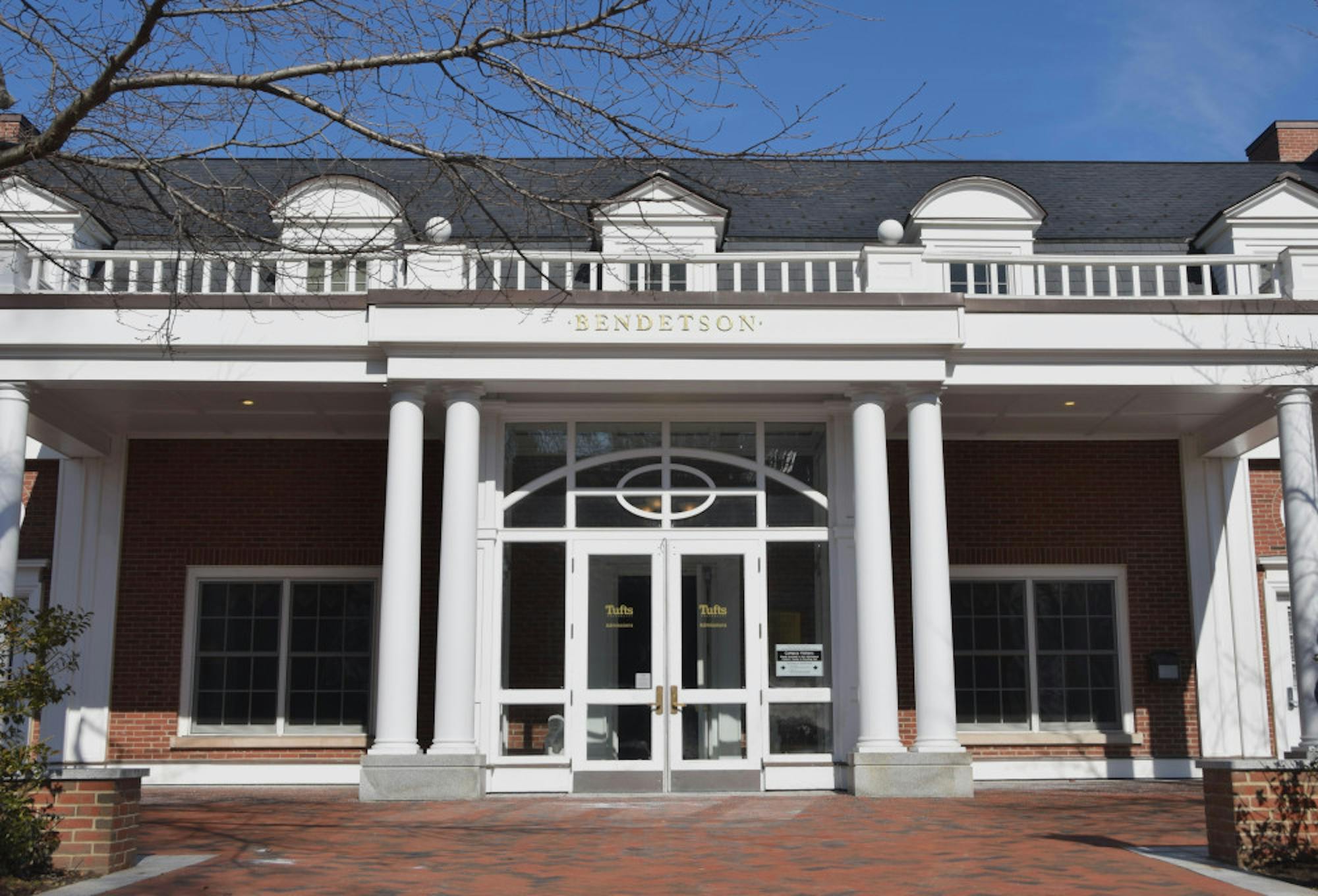Early Decision (ED) is a binding method of admission by which students apply early to a single school -- usually their first choice -- and pledge to attend if accepted. In an email to the Daily, Karen Richardson, dean of undergraduate admissions and enrollment management, stated that she expects at least half of the Class of 2022 will come from the ED applicant pool.
History of early admission programs
According to documents obtained from the Digital Collections and Archives, in the 1959-1960 bulletin, a new heading of “Early Decisions” was introduced.
“Serious, well-qualified applicants who know they wish to enter Tufts may apply for early decision prior to March 15 of the Senior year [of high school]," the bulletin reads.
Eventually, Michael Behnke, who served as dean of admissions from 1976 to 1985, made early applications a permanent fixture on the hill, according to a 2017 article in Tufts Magazine.
For the Classes of 2012 and 2013, Tufts chose not to publicize the number of ED applications it received, in a move designed to make the college admissions process less stressful for future applicants, according to a Jan. 23, 2009 Daily article.
Richardson said that the number of applications for ED has increased steadily over the past ten years, but the acceptance rate has not changed as significantly given the increase. However, the percentage of the incoming first-year class that was admitted ED has shifted accordingly, Richardson noted.
“We don’t go into the early process with a set percentage in mind,” Richardson told the Daily in an email. “Rather, we see the students admitted through [early admissions] as setting the foundation for the incoming class.”
Experiences of current students
Junior Sammy Levy was drawn to Tufts and made the decision to apply ED, because she liked its location and the opportunity for students to explore a range of different disciplines.
“I chose Tufts because I liked having family nearby, as well as the flexibility to study liberal arts and/or engineering depending on what I discovered I liked more,” Levy said. “Ultimately I’m really happy that I did apply because I found Human Factors Engineering, and that’s not offered at a lot of schools.”
While Levy applied under ED I, in which applicants have a deadline of November 1 and are notified of admission results in mid-December, Tufts also offers a later deadline under ED II.
“Tufts offers Early Decision II because some students have not yet decided by Nov. 1 that Tufts is their first choice,” Richardson said. “ED II gives a student who knows that Tufts is their first choice the ability to apply by Jan. 1 and learn their decision by mid-February.”
Despite this flexibility in deadlines, first-yearAlyssa Blaise did not apply early to Tufts or any other schools in large part due to her uncertainty about financial aid.
“I didn’t want to be committed to a school and then be offered a financial aid package that didn’t meet my family’s needs,” Blaise said. “I’m also not sure how one would navigate that kind of situation of having to argue for more once you’ve already basically told the school you’re going to come, so I didn’t even want [to] consider that possibility.”
While Tufts meets 100 percent of demonstrated financial need for all admitted students and would offer the same financial aid package to a student regardless of whether they applied Regular Decision (RD) or ED, Richardson said that the admissions office advises potential applicants that ED may not be the best option for students who wish to compare financial aid packages, as applicants will have to make a binding commitment to attend the university if admitted.
However, Richardson noted that Tufts will allow a student to back out of the ED agreement for financial reasons after working with the financial aid office to determine if a resolution is possible.
For Blaise, applying ED meant she would have had to be confident that she and her family would be fine with the financial aid package the school offered her, in addition to knowing that the school she was applying to was the right fit.
“I leveraged my financial aid offers from other schools against Tufts in order to try and get a better package,” she said. “Besides financial aid, there weren’t any schools that I immediately clicked with. It’s different for everybody; I see the appeal of knowing ahead of time and not having to pay for and send out tons of applications, but I liked all the schools I applied to and was very torn about where I should go.”
Levy also deliberated about where she wanted to go to college, but financial aid was not a deciding factor in her choice.
“My parents have always been very frugal, but when it came to my education that was something they said we’d never look for a discount for, so I’m incredibly lucky that financial aid wasn’t a deciding factor when it came to applying to college,” Levy said. “However, I think if money was a part of the picture, then I might not have looked at a school like Tufts.”
Recent trend of early admissions
While ED offers students the ability to show a school that it is the student’s first choice and to hear back earlier in the college admissions process, there has been some criticism that ED favors the more privileged and leaves other applicants at a disadvantage. In 2006, the University of Virginiaannounced that it was ending its ED program in an effort to attract more low-income students; it now uses Early Action.
“[Tufts does] not offer Early Action, which is non-binding and would make projections of yield very difficult, putting the university at risk of over- or under-enrolling from year to year,” Richardson said.
Tufts is not alone in embracing and using ED to its advantage. ED provides security not only for college applicants, but also for the schools themselves. For colleges and universities, ED provides stability in a volatile, frenzied college admissions market. ED also enables a school to become more selective with a lower overall acceptance rate, and increase its yield because it already has a certain percentage of admitted students guaranteed to attend.
Both Levy and Blaise believe it’s important for prospective applicants to weigh the pros and cons of applying ED and to know if and why the school is right for them.
“I’d say only apply if you’re confident that that school is a good fit for you and you’ve explored and are okay with the financial aid policies, if that’s something that applies to you," Blaise said.
Levy echoed this sentiment.
“If the academics, the opportunities, the campus culture and other important things check their boxes, then I’d encourage [a prospective student] to apply ED,” she said. “But I think kids are told if they don’t know exactly where they want to go, they won’t have a chance of getting in. So some people may feel pressured to do ED because they see the majority of a class being accepted [that] way.”
While the pool of applications is much smaller for ED than RD, the process Tufts uses and the criteria for admission are the same, according to Richardson. She also emphasized that it is not easier to get in ED, contrary to popular belief.
“The biggest difference between ED and [RD] students is that those who apply ED have already decided that Tufts is the place that they want to be,” Richardson said. “As the ED pool has grown and gotten stronger, it’s difficult to say ‘no’ to good students who are good fits and who have made the commitment to attend if accepted.”
Richardson’s statement reflects the upward trend of ED applications and class composition: ED applicants made up 35 percent of the class of 2015 and 39 percent of the class of 2016, while approximately half of the classes of 2021 and 2020 came from ED.
“I definitely think applying ED will become even more the norm in the future,” Levy said. “If ... 50 percent of the current [first-year] class is ED, does that mean in another 10 years 60 percent could be from ED?”
The early bird applicant: Trends in early admissions at Tufts

Bendetson Hall, Office of Undergraduate Admissions, is pictured.





